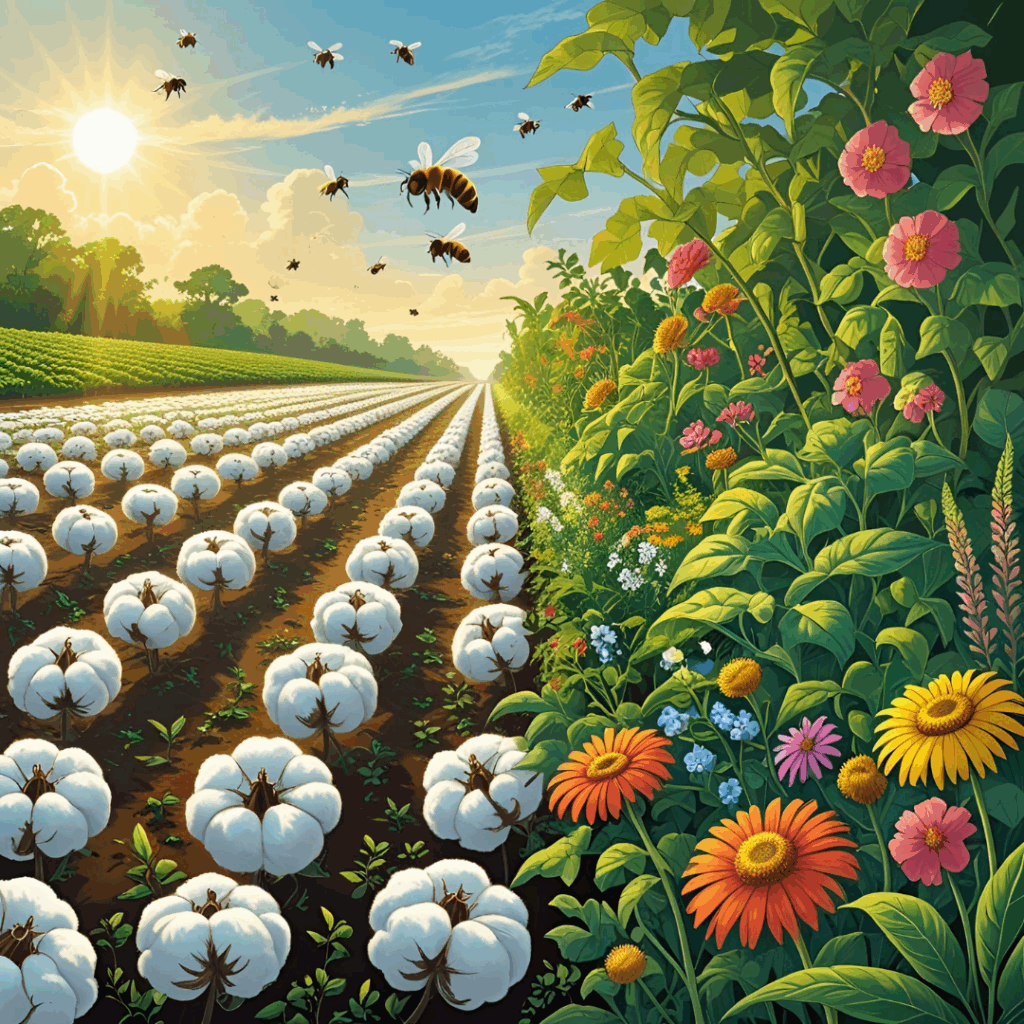In today’s eco-conscious fashion world, what we wear is no longer just a matter of style—it’s a statement about the world we want to live in. One of the most significant yet overlooked choices is the kind of fabric we choose. Natural fibers, especially organic cotton, have a profound connection to biodiversity and the health of ecosystems around the globe. This post unpacks how the cultivation of organic cotton differs from traditional methods and why that matters for wildlife conservation.
The Problem with Conventional Cotton and Monoculture
What is monoculture and why is it harmful?
Monoculture refers to the agricultural practice of growing a single crop over vast areas of land. In the case of conventional cotton farming, this method dominates. While it increases short-term yields, monoculture has several long-term negative effects:
- Habitat destruction: Large-scale cotton farms often replace diverse natural habitats like forests, wetlands, or grasslands.
- Pesticide and herbicide use: Conventional cotton is responsible for about 16% of global insecticide use, harming pollinators and contaminating nearby ecosystems.
- Soil degradation: Repeated planting of a single crop depletes the soil of nutrients and weakens its structure, making it harder for diverse life to thrive.
- Water overuse: Cotton is a water-thirsty crop, especially when grown in arid regions, reducing available freshwater for ecosystems and animals.
The result? A landscape stripped of its natural complexity—fewer plant species, no shelter or food for local wildlife, and ecosystems teetering on collapse.

Organic Cotton: A Biodiversity Ally
What makes organic cotton different?
Organic cotton is grown without synthetic pesticides, herbicides, or genetically modified seeds. But its benefits go far beyond the absence of chemicals:
- Crop rotation and polyculture: Organic farms often rotate crops or plant multiple species together, restoring nutrients to the soil and attracting diverse insect and bird species.
- No toxic chemicals: This protects soil microbes, bees, butterflies, and aquatic life from harmful runoff.
- Support for soil health: Compost and natural fertilizers improve soil structure and foster life underground, from earthworms to fungi.
- Water conservation: Organic cotton uses rain-fed irrigation whenever possible, preserving freshwater habitats.
These practices help rebuild ecosystems, making farms part of the solution rather than the problem.
Case studies and impact data
- A 2023 study by the Textile Exchange found that organic cotton farming supported 20% higher biodiversity levels than conventional cotton fields.
- In India, organic cotton farms showed greater populations of birds, frogs, and beneficial insects due to reduced pesticide use.
- According to the Soil Association, organic farms support up to 50% more species of plants, pollinators, and birds compared to intensive monoculture fields.
These numbers show that organic cotton isn’t just less harmful—it can actively support biodiversity.
The Bigger Picture: Fashion and Habitat Loss
Fashion’s supply chain extends far beyond the catwalk. From cotton fields to clothing factories, every stage impacts natural ecosystems.
Wildlife at risk
- Insects: Bees and butterflies, essential for pollination, are poisoned by chemicals used in conventional farming.
- Birds: Many bird species lose nesting grounds when forests are cleared for cotton monoculture.
- Aquatic life: Pesticide-laden runoff pollutes rivers and lakes, leading to fish die-offs and damaged freshwater biodiversity.
- Soil organisms: Fertile soil is teeming with life. Monoculture and chemical use disrupt the delicate balance, killing off beneficial fungi and invertebrates.
Supporting organic cotton is one way for consumers to reduce their impact on these vulnerable groups.
How Consumers Can Drive Change
Today’s conscious consumers hold more power than ever. Choosing organic textiles supports sustainable farming and sends a clear message to the fashion industry.
Look for certifications
- GOTS (Global Organic Textile Standard): Ensures that textiles meet strict organic and ecological criteria.
- Soil Association Organic: Guarantees high biodiversity and animal welfare standards in farming.
Buy less, choose better
- Invest in high-quality organic cotton pieces that last.
- Support brands that prioritize transparency and environmental ethics.
Ask brands the right questions
- Where do your fabrics come from?
- Is your cotton organically and ethically grown?
- What steps do you take to protect biodiversity?
The more we ask, the more pressure brands feel to shift toward greener, wildlife-friendly practices.
A Look Ahead: Regenerative Cotton and Eco-Fashion Futures
Looking to the future, the conversation is evolving beyond sustainability toward regeneration—farming and production methods that actively heal the planet.
Regenerative agriculture and biodiversity
Some cotton farms are beginning to adopt regenerative practices, such as:
- Cover cropping to prevent soil erosion and provide habitat for small animals.
- Integrating trees and hedgerows that serve as corridors for birds and insects.
- Using livestock strategically to improve soil health and plant diversity.
These techniques turn farms into wildlife-friendly landscapes.
Innovation in materials
- Hemp and linen: Fast-growing, low-impact natural fibers that support diverse ecosystems.
- Closed-loop production: Systems that recycle water and avoid chemical pollution.
With the help of consumers, innovators, and environmental advocates, fashion can become a force for nature.
Voices from the Field
- “When we switched to organic cotton, our fields started buzzing with insects again. Birds came back. The soil is alive.” — Amar, cotton farmer, Maharashtra, India.
- “Our customers love that their T-shirts protect wildlife habitats. We work with certified farms that promote biodiversity.” — Lena, sustainable fashion brand owner, UK.
- “Organic textiles help heal ecosystems. They’re not just better for us—they’re better for the whole web of life.” — Dr. Ellen Green, ecologist and textile researcher.
These voices echo a growing movement connecting fashion to ecological stewardship.
Why It Matters
Choosing a cotton shirt might seem like a small act. But when multiplied across millions of consumers, it becomes a collective force for change. By supporting organic and natural fabrics, we protect the creatures that pollinate our food, clean our air, and keep ecosystems resilient.
Fashion can be a habitat hero—if we make the right choices.







